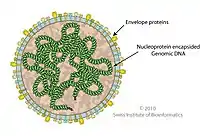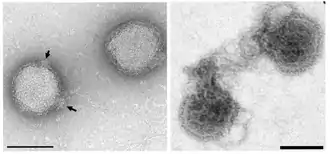Globuloviridae
Globuloviridae ist die Bezeichnung für eine Familie hyperthermophiler Viren.
Als natürliche Wirte dienen Archaeen Gattungen Pyrobaculum [en]
und Thermoproteus [en] (beide Crenarchaeota).
Derzeit gibt es nur zwei Spezies (Arten) in dieser Familie, Pyrobaculum spherical virus (PSV) und Thermoproteus tenax spherical virus 1 (TTSV1), zusammengefasst in der einzigen Gattung, Globulovirus.[2][3]
Es wurden zwei weitere vorläufige Mitglieder der Familie, „Pyrobaculum spherical virus 2“ (PSV2)[4]
und „Thermoproteus spherical piliferous virus 1“ (TSPV1)[5]
isoliert, aber nicht offiziell bestätigt.
| Globuloviridae | ||||||||||||||||
|---|---|---|---|---|---|---|---|---|---|---|---|---|---|---|---|---|

Globuloviridae-Virion | ||||||||||||||||
| Systematik | ||||||||||||||||
| ||||||||||||||||
| Taxonomische Merkmale | ||||||||||||||||
| ||||||||||||||||
| Wissenschaftlicher Name | ||||||||||||||||
| Globuloviridae | ||||||||||||||||
| Links | ||||||||||||||||
|

Aufbau
Die Virionen der Globuloviridae sind kugelförmig (sphärisch) und (vermutlich) umhüllt. Der Durchmesser beträgt etwa 100 nm.[2][3]

Das Genom der Globuloviridae ist ein einzelnes, lineares Doppelstrang-DNA-Molekül (unsegmentiert, d. h. monopartit). Es hat eine Länge von etwa 20–30 kbp (Kilobasenpaare).[2][3]
Reproduktionszyklus
Globuloviren reproduzieren im Zytoplasma der Wirtszellen. Die Transkription erfolgt anhand der genomischen DNA als Vorlage. Als natürliche Wirte dienen Archaeen der Gattungen Pyrobaculum und Thermoproteus (beide Thermoproteaceae [en], Crenarchaeota). Die Übertragung geschieht durch passive Diffusion.[2][3]
Systematik
Die Systematik der Globuloviridae ist nach ICTV (ergänzt durch Vorschläge in doppelten Anführungszeichen nach NCBI) wie folgt:[2]
Gruppe: dsDNA
Ordnung: nicht klassifiziert
- Familie Globuloviridae
- Gattung Globulovirus
- Spezies Pyrobaculum spherical virus (Typus, TSV)
- Spezies Thermoproteus tenax spherical virus 1 (TTSV1)
- Spezies „Pyrobaculum spherical virus 2“ (PSV2)
- Spezies „Thermoproteus spherical piliferous virus 1“ (TSPV1)
Literatur
- Häring M, Peng X, Brügger K, Rachel R, Stetter KO, Garrett RA, Prangishvili D: Morphology and genome organization of the virus PSV of the hyperthermophilic archaeal genera Pyrobaculum and Thermoproteus: a novel virus family, the Globuloviridae. In: Virology. 323, Nr. 2, 2004, S. 233–242. doi:10.1016/j.virol.2004.03.002. PMID 15193919.
Einzelnachweise
- ICTV: ICTV Master Species List 2019.v1, New MSL including all taxa updates since the 2018b release, March 2020 (MSL #35)
- D Prangishvili, M Krupovic, ICTV Report Consortium: ICTV Virus Taxonomy Profile: Globuloviridae. In: The Journal of General Virology. 99, Nr. 10, 2018, S. 1357–1358. doi:10.1099/jgv.0.001123. PMID 30091697.
- Viral Zone. ExPASy. Abgerufen am 23. Februar 2021.
- DP Baquero, P Contursi, M Piochi, S Bartolucci, Y Liu, V Cvirkaite-Krupovic, D Prangishvili, M Krupovic: New virus isolates from Italian hydrothermal environments underscore the biogeographic pattern in archaeal virus communities. In: The ISME Journal. 2020. doi:10.1038/s41396-020-0653-z. PMID 32322010.
- R Hartman, L Biewenga, J Munson-McGee, M Refai, ES Boyd, B Bothner, CM Lawrence, M Young: Discovery and Characterization of TSPV1: A Spherical Archaeal Virus Decorated with Unusual Filaments. In: Journal of Virology. 94, Nr. 11, 2020. doi:10.1128/JVI.00036-20. PMID 32213609.